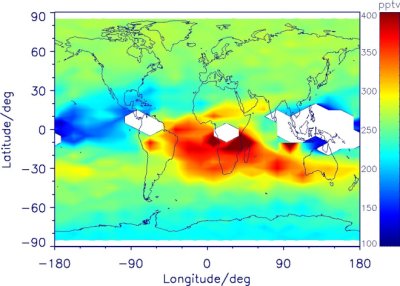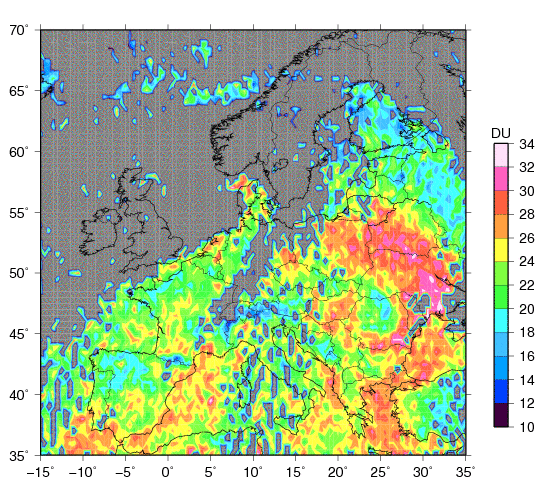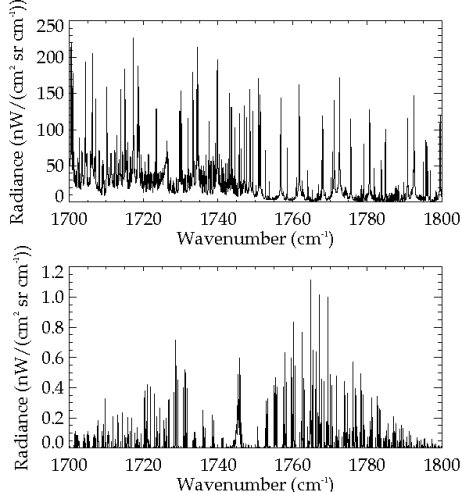Contributions
The IMK team will analyse limb emission spectra measured by the Michelson Interferometer for Passive Atmospheric Sounding (MIPAS) on Envisat
[Fischer et al., 2008]
with respect to atmospheric pollutants in the upper
troposphere and lower stratosphere. The following aspects will be covered:
-
Creation of global fields of O3, CO,
C2H6, C2H2, HNO3,
HNO4, PAN, HCN and H2CO
and others (NH3, formic acid, methanol, acetone, OCS,
CH3CN, ... retrieval to be developed) in the UTLS for dedicated
episodes.
-
Search for new species in MIPAS spectra using new spectroscopic data provided
by LISA.
-
Development of the "chemical fingerprint method" to distinguish different
sources of pollution.
-
Identification of troposphere-to-stratosphere transport from the observational
data.

|
Global HCN distribution at 12 km altitude derived from MIPAS measurements
between 9 September and 30 November 2003. The distribution
reflects the southern hemispheric biomass burning plume extending from Brasil
over Southern Africa and Australia into the Southern Pacific.
|
The LISA team will give the following scientific contributions:
- IASI data:
-
Retrieval of tropospheric ozone columns over Europe and development of the CO
retrieval (in collaboration with the Laboratoire d'Aérologie). These
data allow direct comparisons with simulations of models focusing on air
quality.
-
Synergistic use of IASI data with data from other sensors (e.g. MIPAS-ENVISAT,
ACE-FTS aboard SCISAT-1).
-
Cross-comparison and validation of spectroscopic data using different infrared
bands.
-
Update of the spectroscopic parameters:
Identification and removal of deficiencies in the spectroscopic data of minor
atmospheric pollutants measured by MIPAS. Supply of spectroscopic parameters
for additional atmospheric pollutants.

Ozone pollution event measured with IASI (0-6 km partial tropospheric
columns) on July 17, 2007 during the heat wave period that occurred in
Central Europe in 2007. Cloudy pixels are shown in grey.
|

Retrieval of global upper tropospheric and stratospheric formaldehyde
(H2CO) distributions from MIPAS-Envisat spectra
[Steck et al., 2008],
using new spectroscopic H2CO data provided by LISA. Top: Simulated
spectrum at 16.4 km tangent altitude; tropical conditions, all gases
included. Bottom: Formaldehyde contribution only (note the different
scale).
|
The team of the Laboratoire
d'Aérologie will use 3-D fields of chemical constituents to assess
the impact of tropical biomass burning up to the lower stratosphere. Main
topics:
-
Emission and transport of pollutants in the lower troposphere:
Systematic comparisons between satellite data sets (MIPAS, IASI etc.) and
MOCAGE simulations based on state-of-the-art inventories.
-
Dynamical and chemical processing of polluted airmasses up to the upper
troposphere:
Detailed investigation of the composition of upper tropospheric plumes based
upon satellite measurements and model as well as assimilation output.
-
Global-scale transport processes up to the lower stratosphere:
Use of MOCAGE to investigate the transport from the upper
troposphere (UT) into the lower stratosphere (LS).
The research team of the MPI-Ch
/
University of Mainz will perform model
simulations of the impact of anthropogenic pollution on the chemical
composition of the extratropical troposphere and lower stratosphere with the
atmospheric chemistry GCM ECHAM5/MESSy
[Jöckel et al., 2006].
The following tasks will be addressed:
-
Quantification of the importance of the different biomass burning source
regions for the global ozone budget and the extratropical UTLS
- model comparison with MOCAGE
- comparison with observations and in-situ measurements
-
Investigation of the effect of different sources of pollution on the
European air quality
- use of characteristic tracers and their ratios to differentiate between different pollution sources
- comparison with MIPAS
-
Case studies:
- investigation of the chemical evolution of single plumes
- plume evolution using newly developed Lagrangian tools for EMAC
-
Transport pathways for pollution in the extratropics
- investigation of the role of convection and pyroconvection in the
extratropics







